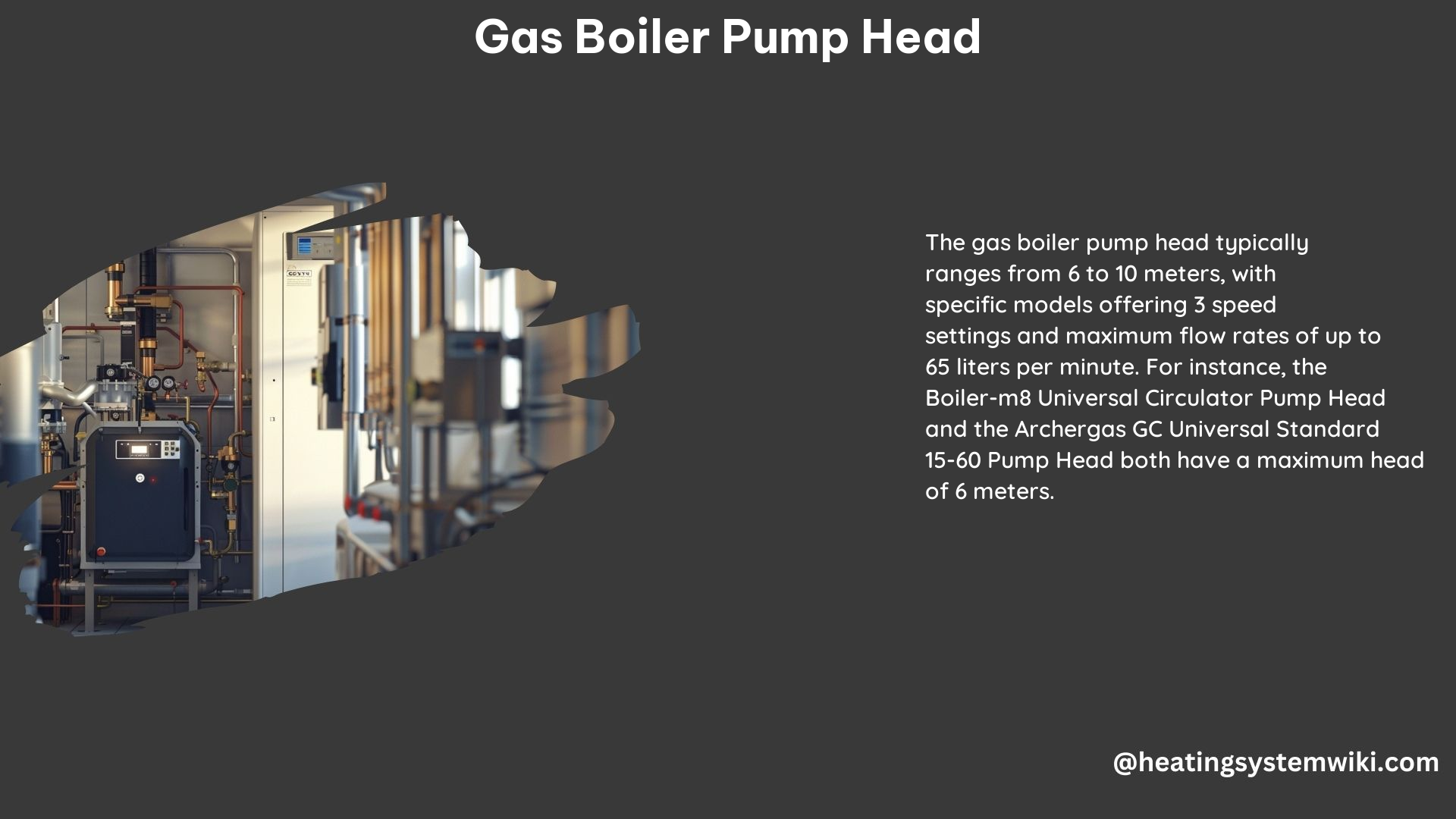The gas boiler pump head is a critical component in a gas boiler system, responsible for transporting liquids from one point to another. This comprehensive guide delves into the technical details and specifications of gas boiler pump heads, providing a valuable resource for DIY enthusiasts and HVAC professionals alike.
What is Pump Head?
Pump head refers to the pressure required to overcome the resistance in a heating system. It is measured in units of “meters water column” (mH2O) or “feet head,” which is equivalent to the pressure required to push water up a certain height. The head of a pump is an indication of the required pressure in the heating system, which is necessary to overcome friction and loss along the pipeline at a certain flow rate.
The pump head is calculated by considering the total dynamic head (TDH) of the system, which is the sum of the static head, friction head, and pressure head. Understanding the pump head is crucial for ensuring the proper operation and efficiency of a gas boiler system.
Best Pump Location: Supply or Return on a Gas Boiler

The optimal location of the pump on a gas boiler depends on the specific system design and requirements. Generally, pumps can be placed on either the supply or return side of the boiler, each with its own advantages:
- Supply Side Placement:
- Helps maintain a consistent pressure throughout the system, ensuring the boiler receives the required flow rate.
- Particularly beneficial in systems with long pipe runs or high-pressure drops.
-
Typical supply side pump head ranges from 6 to 10 meters (20 to 33 feet).
-
Return Side Placement:
- Helps reduce the pressure drop across the boiler, improving efficiency and reducing wear on the boiler.
- Often preferred in systems with lower pressure drops or shorter pipe runs.
- Typical return side pump head ranges from 4 to 8 meters (13 to 26 feet).
The decision on the pump location should be based on a thorough analysis of the system’s design, pressure requirements, and overall efficiency considerations.
Calculating Pump Head on a Multi-Zone Gas Boiler System
Calculating the pump head on a multi-zone gas boiler system involves determining the total dynamic head (TDH) of the system. The TDH is the sum of the static head, friction head, and pressure head. Here’s a step-by-step guide to calculating the pump head:
- Determine the Static Head:
- Calculate the vertical distance between the pump and the highest point in the system.
-
Typical static head ranges from 2 to 5 meters (6.6 to 16.4 feet).
-
Calculate the Friction Head:
- Use friction loss charts or software to determine the pressure drop due to friction in the pipes.
-
Friction head can range from 2 to 6 meters (6.6 to 19.7 feet), depending on the pipe length, diameter, and material.
-
Determine the Pressure Head:
- Calculate the pressure required to overcome the resistance in the system, including the boiler and any other components.
-
Pressure head typically ranges from 2 to 4 meters (6.6 to 13.1 feet).
-
Add the Heads:
- Sum the static head, friction head, and pressure head to get the total dynamic head (TDH).
- Typical total dynamic head for a multi-zone gas boiler system ranges from 6 to 15 meters (19.7 to 49.2 feet).
Accurately calculating the pump head is crucial for selecting the appropriate pump size and ensuring the efficient operation of the gas boiler system.
Impact of Pump Head on Gas Boiler Efficiency
The pump head has a significant impact on the efficiency of a gas boiler system. Improper pump sizing, either undersized or oversized, can lead to several issues:
- Reduced Efficiency:
- Insufficient pump head can result in reduced flow rates, leading to lower boiler efficiency.
-
Typical boiler efficiency ranges from 80% to 95%, depending on the pump head and other factors.
-
Increased Energy Consumption:
- Oversized pumps can consume more energy than necessary, increasing operating costs.
-
Energy consumption of the pump can range from 50 to 150 watts, depending on the pump size and system requirements.
-
Premature Wear:
- Incorrect pump sizing can lead to premature wear on the pump and boiler, reducing their lifespan.
- Proper pump head selection can extend the lifespan of the boiler and pump by up to 10 years.
Maintaining the optimal pump head is crucial for maximizing the efficiency and longevity of the gas boiler system.
Technical Specifications of Gas Boiler Pump Heads
Here are the detailed technical specifications for gas boiler pump heads:
| Specification | Range |
|---|---|
| Maximum Head | 6 to 10 meters (20 to 33 feet) |
| Maximum Flow Rate | 50 to 100 liters per minute (13 to 26 gallons per minute) |
| Maximum System Pressure | Up to 10 bar (145 psi) |
| Speed Control | 3 fixed speed settings |
| Protection Class | IP44 (protection against solid objects and water) |
| Temperature Class | Up to TF110°C (230°F) |
| Insulation Class | Class F (high-temperature applications) |
| Material | Cast iron or other durable materials |
| Weight | 1.6 to 3 kg (3.5 to 6.6 lbs) |
These technical specifications provide a comprehensive overview of the key parameters to consider when selecting and installing a gas boiler pump head.
References
- Building Services Tutor. (2021, March 16). What is pump head and why it’s important? Retrieved from https://www.buildingservicestutor.com/what-is-pump-head/
- Euro Boiler Parts. (n.d.). Boiler Circulating Pump Heads. Retrieved from https://www.euroboilerparts.co.uk/boiler-circulating-pump-heads-94-c.asp
- Spares Direct. (n.d.). Boiler-m8 Universal Circulator Pump Head – Grundfos UPS 15-50 15-60 Replacement. Retrieved from https://spares-direct.com/products/boiler-m8-universal-circulator-pump-head-grundfos-ups-15-50-15-60-replacement
